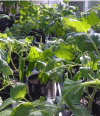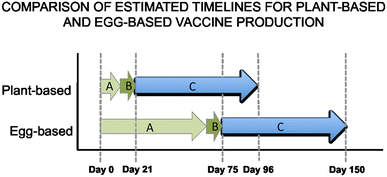Plant-made vaccines in support of the Millennium Development Goals
- PMID: 21243362
- PMCID: PMC3075396
- DOI: 10.1007/s00299-010-0995-5
Plant-made vaccines in support of the Millennium Development Goals
Abstract
Vaccines are one of the most successful public health achievements of the last century. Systematic immunisation programs have reduced the burden of infectious diseases on a global scale. However, there are limitations to the current technology, which often requires costly infrastructure and long lead times for production. Furthermore, the requirement to keep vaccines within the cold-chain throughout manufacture, transport and storage is often impractical and prohibitively expensive in developing countries-the very regions where vaccines are most needed. In contrast, plant-made vaccines (PMVs) can be produced at a lower cost using basic greenhouse agricultural methods, and do not need to be kept within such narrow temperature ranges. This increases the feasibility of developing countries producing vaccines locally at a small-scale to target the specific needs of the region. Additionally, the ability of plant-production technologies to rapidly produce large quantities of strain-specific vaccine demonstrates their potential use in combating pandemics. PMVs are a proven technology that has the potential to play an important role in increasing global health, both in the context of the 2015 Millennium Development Goals and beyond.
Figures


Similar articles
-
Plant-made vaccine antigens and biopharmaceuticals.Trends Plant Sci. 2009 Dec;14(12):669-79. doi: 10.1016/j.tplants.2009.09.009. Epub 2009 Oct 14. Trends Plant Sci. 2009. PMID: 19836291 Free PMC article. Review.
-
Ethics, biotechnology, and global health: the development of vaccines in transgenic plants.Am J Bioeth. 2006 Jul-Aug;6(4):W29-41. doi: 10.1080/15265160600843551. Am J Bioeth. 2006. PMID: 16885087
-
Chloroplast-derived vaccines against human diseases: achievements, challenges and scopes.Plant Biotechnol J. 2011 Jun;9(5):527-39. doi: 10.1111/j.1467-7652.2011.00615.x. Epub 2011 Mar 29. Plant Biotechnol J. 2011. PMID: 21447052 Review.
-
Plant-made vaccines for humans and animals.Plant Biotechnol J. 2010 Jun;8(5):620-37. doi: 10.1111/j.1467-7652.2010.00507.x. Epub 2010 Mar 11. Plant Biotechnol J. 2010. PMID: 20233333 Free PMC article. Review.
-
The Pragmatic Introduction and Expression of Microbial Transgenes in Plants.J Microbiol Biotechnol. 2018 Dec 28;28(12):1955-1970. doi: 10.4014/jmb.1808.08029. J Microbiol Biotechnol. 2018. PMID: 30394044 Review.
Cited by
-
Evolution of plant-made pharmaceuticals.Int J Mol Sci. 2011;12(5):3220-36. doi: 10.3390/ijms12053220. Epub 2011 May 17. Int J Mol Sci. 2011. PMID: 21686181 Free PMC article. Review.
-
Need of cost-effective vaccines in developing countries: What plant biotechnology can offer?Springerplus. 2016 Jan 22;5:65. doi: 10.1186/s40064-016-1713-8. eCollection 2016. Springerplus. 2016. PMID: 26839758 Free PMC article. Review.
-
An evaluation of the emerging vaccines against influenza in children.BMC Public Health. 2013;13 Suppl 3(Suppl 3):S14. doi: 10.1186/1471-2458-13-S3-S14. Epub 2013 Sep 17. BMC Public Health. 2013. PMID: 24564565 Free PMC article. Review.
-
Plant biotechnology in support of the Millennium Goals II.Plant Cell Rep. 2011 May;30(5):677-9. doi: 10.1007/s00299-011-1063-5. Plant Cell Rep. 2011. PMID: 21442401 No abstract available.
-
Isolation, cloning and transgenic expression of hepatitis B surface antigen (HBsAg) in Solanum lycopersicum L.Saudi J Biol Sci. 2022 Mar;29(3):1559-1564. doi: 10.1016/j.sjbs.2021.11.012. Epub 2021 Nov 16. Saudi J Biol Sci. 2022. PMID: 35280581 Free PMC article.
References
-
- Atkinson WL, Pickering LK, Schwartz B, Weniger BG, Iskander JK, Watson JC. General recommendations on immunization. Recommendations of the Advisory Committee on Immunization Practices (ACIP) and the American Academy of Family Physicians (AAFP) MMWR Recomm Rep. 2002;51:1–36. - PubMed
-
- Barr IG, McCauley J, Cox N, Daniels R, Engelhardt OG, Fukuda K, Grohmann G, Hay A, Kelso A, Klimov A, Odagiri T, Smith D, Russell C, Tashiro M, Webby R, Wood J, Ye Z, Zhang W, Writing Committee of the WHO Consultation on Northern Hemisphere Influenza Vaccine Composition for 2009–2010 Epidemiological, antigenic and genetic characteristics of seasonal influenza A (H1N1) and B influenza viruses: basis for the WHO recommendation on the composition of influenza vaccines for use in the 2009–2010 Northern Hemisphere season. Vaccine. 2010;5:1156–1167. doi: 10.1016/j.vaccine.2009.11.043. - DOI - PubMed
-
- Bendandi M, Marillonnet S, Kandzia R, Thieme F, Nickstadt A, Herz S, Fröde R, Inogés S, Lòpez-Dìaz de Cerio A, Soria E, Villanueva H, Vancanneyt G, McCormick A, Tusé D, Lenz J, Butler-Ransohoff J-E, Klimyuk V, Gleba Y. Rapid, high-yield production in plants of individualized idiotype vaccines for non-Hodgkin’s lymphoma. Ann Oncol. 2010;21:2420–2427. doi: 10.1093/annonc/mdq256. - DOI - PubMed
Publication types
MeSH terms
Substances
LinkOut - more resources
Full Text Sources
Medical

